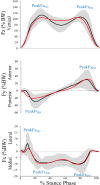The long-term use of foot orthoses affects walking kinematics and kinetics of children with flexible flat feet: A randomized controlled trial
- PMID: 30300405
- PMCID: PMC6177172
- DOI: 10.1371/journal.pone.0205187
The long-term use of foot orthoses affects walking kinematics and kinetics of children with flexible flat feet: A randomized controlled trial
Abstract
Background: Due to inconclusive evidence on the effects of foot orthoses treatment on lower limb kinematics and kinetics in children, studies are needed that particularly evaluate the long-term use of foot orthoses on lower limb alignment during walking. Thus, the main objective of this study was to evaluate the effects of long-term treatment with arch support foot orthoses versus a sham condition on lower extremity kinematics and kinetics during walking in children with flexible flat feet.
Methods: Thirty boys aged 8-12 years with flexible flat feet participated in this study. While the experimental group (n = 15) used medial arch support foot orthoses during everyday activities over a period of four months, the control group (n = 15) received flat 2-mm-thick insoles (i.e., sham condition) for the same time period. Before and after the intervention period, walking kinematics and ground reaction forces were collected.
Results: Significant group by time interactions were observed during walking at preferred gait speed for maximum ankle eversion, maximum ankle internal rotation angle, minimum knee abduction angle, maximum knee abduction angle, maximum knee external rotation angle, maximum knee internal rotation angle, maximum hip extension angle, and maximum hip external rotation angle in favor of the foot orthoses group. In addition, statistically significant group by time interactions were detected for maximum posterior, and vertical ground reaction forces in favor of the foot orthoses group.
Conclusions: The long-term use of arch support foot orthoses proved to be feasible and effective in boys with flexible flat feet to improve lower limb alignment during walking.
Conflict of interest statement
The authors have declared that no competing interests exist.
Figures





References
-
- Ozonoff MB. Pediatric Orthopedic Radiology. J Pediatr Orthop. 1992; 12(4): 548.
Publication types
MeSH terms
LinkOut - more resources
Full Text Sources

